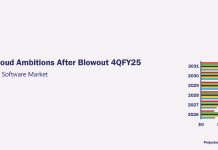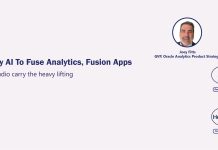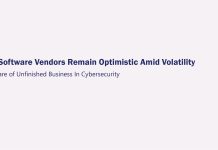
Using #thinkautonomous as the recurring theme, Oracle kicked off a new round of database announcements yesterday to reassert its dominance in a market that it has been leading for much of the 21st century. Sustaining the incumbent advantage will require more thinking.
Co-founder and chief technology officer Larry Ellison unveiled Oracle Autonomous Transaction Processing, following the March 2018 availability of Oracle Autonomous Data Warehouse and 18c – the main piece of Oracle Autonomous Database, which started shipping a month earlier. Ellison even gave a teaser of 19c due out next year. With the latest products, customers can effectively run their entire workloads for everything from Internet of Things to Machine Learning using a combination of Oracle Autonomous technologies including complementary Cloud services for Analytics, AppDev, Blockchain, DevOps, Integration, Mobility and Security.
What’s remarkable is that customers will be able to run the new Oracle database so effortlessly by leveraging rapid upgrade tools and bring your own on-premise license flexibility, less costly by trying it for free for 3,300 hours and most importantly autonomously by eliminating a host of laborious tasks like patching, tuning, threat detection and remediation through automation.
Over the past few decades, Oracle has led the database market after beating Informix (now IBM), Sybase (now SAP) and others at their own game both in terms of price performance and a well-executed acquisition strategy (buying apps vendors to bring them into its database fold). In recent years, Oracle database license and maintenance revenues and database-led sales were contributing up to half of its total revenues, or as much as $20 billion in its fiscal 2018, according to our estimates.
Mounting competition from open source and non-relational databases including NoSQL, coupled with the endurance of Microsoft SQL, IBM DB2, as well as the expansion of Amazon database options like Aurora, Dynamo DB, RDS, and Redshift for millions of AWS users, have threatened to erode Oracle’s giant footprint in the database market.
What’s at stake is not just the future of Oracle, but also how enterprises drive value from their database, which is becoming inseparable from their business imperative. The thought of Facebook without its trove of user data is simply unthinkable.
The good news is that long-time Oracle customers are warming up to its new database offerings, as told by BBC, Bechtel, Gap, Thomson Reuters, Underwriters Laboratories, Union Pacific, Yamaha and many other big businesses that our research team has been able to document in recent months.
During the launch event, Oracle also brought in Droptank, a loyalty vendor for a gas station and convenience store brands, and Data Intensity, a Cloud developer, to demonstrate how these young companies are making use of the latest Oracle products to handle tasks. The former provides real-time access to Oracle Cloud Database with thousands of point-of-sale locations and a projected 50x transaction boost in 2019, while the latter focuses on accelerating hundreds of Cloud migration use cases by using Oracle Autonomous technologies.
These are the fast-growing startups, innovative companies and white-space markets where Oracle will have to win in order to defend itself against further incursion from Amazon and the likes.
Winning them over will require overriding the previous perception of Oracle database as something that is costly, hard to run and perhaps an overkill, especially among the uninitiated that are accustomed to cheap, no-brainer and generic Cloud services.
That’s why the suite of Oracle Autonomous products is designed to run behind the scenes, unobtrusively, self-correcting and largely sight unseen.
The question is how can Oracle package something that is almost invisible to users? I venture to give some answers.
- Market the new Oracle database heavily to the uninitiated because they may be easier to sway than the trained users when they compare the ease of use of Oracle Autonomous approach with what’s readily available from other Cloud vendors – similar to pitching electric or self-driving cars to those that have never driven a gas-powered vehicle. Sometimes one really can’t teach an old dog new tricks.
- Eschewing one-size-fits-all Cloud services, Oracle now makes public, private and hybrid cloud databases available by tailoring its offerings to meet specific customer needs under its Cloud@Customer program. What’s more important is to turn the deployment flexibility, 99.995% availability and pay-per-use utility model into prescriptive Cloud delivery that aligns with the risk profiles of its customers, similar to the mileage-based automobile insurance policy. Customers will be better served knowing that they will not be penalized for over consuming databases that they don’t need and some may end up sharing the risks with the vendor because of the peaks and valleys associated with running a disruptive business like IoT or cryptocurrency. Enjoying the incumbent advantage after selling database for decades, Oracle has the wherewithal to anticipate and predict customer needs and expectations. Oracle Autonomous Database could become the invisible hand that helps customers remove IT complexity while providing the reassurance and predictability needed to run their high-velocity operations.
- Humanize the messaging of Oracle Autonomous with a mascot that is humanoid but not robotic and threatening. It’s as if an invisible superhero suddenly appearing out of nowhere to save the world. Amazon has Alexa, Apple Siri, IBM Watson, SAP Leonardo and Oracle needs a gentle giant that serves as a security blanket and a smart machine at the same time.
Backed by its key differentiators like fault-tolerance through application clustering, security updates and software patches easily done online and a fully integrated hardware and software infrastructure, the broadening of the Oracle Autonomous suite comes at an opportune time just as enterprise customers and developers are evaluating a range of possibilities to address their immediate and long-term pain points.
According to recent research projects that we have embarked on to gauge future technology purchases, the majority of developers consider it important to add a new database management solution as part of their digital transformation initiative because the intrinsic and often intangible value of a reliable, scalable and self-driving database has never been more pronounced to the integrity and viability of their platform and applications development efforts.
Ellison is spot on to point out that the real value of Oracle Autonomous Database lies in freeing up key stakeholders from the onerous tasks of patching, tuning and securing one’s database thus allowing them to innovate and build more useful applications and realize more value from their customer and operational data.
Making Oracle Autonomous Database resonate with a new generation of users and customers will require more than the promises of unsurpassed reliability, security and price and performance. In fact, Oracle may have to make the Invisible Database stand out, part of the common lexicon, cerebral as well as inspirational for millions of new and existing users.





